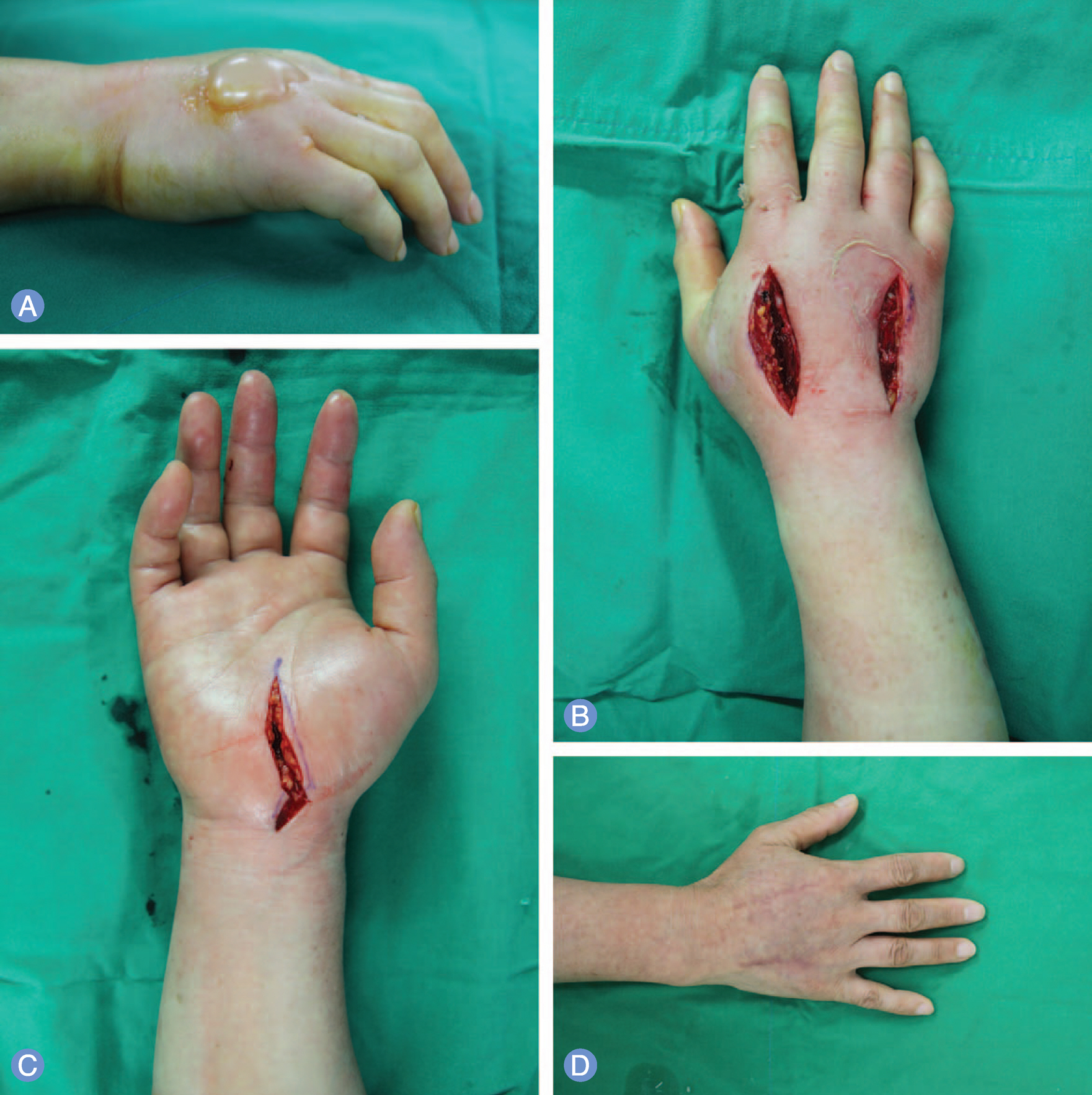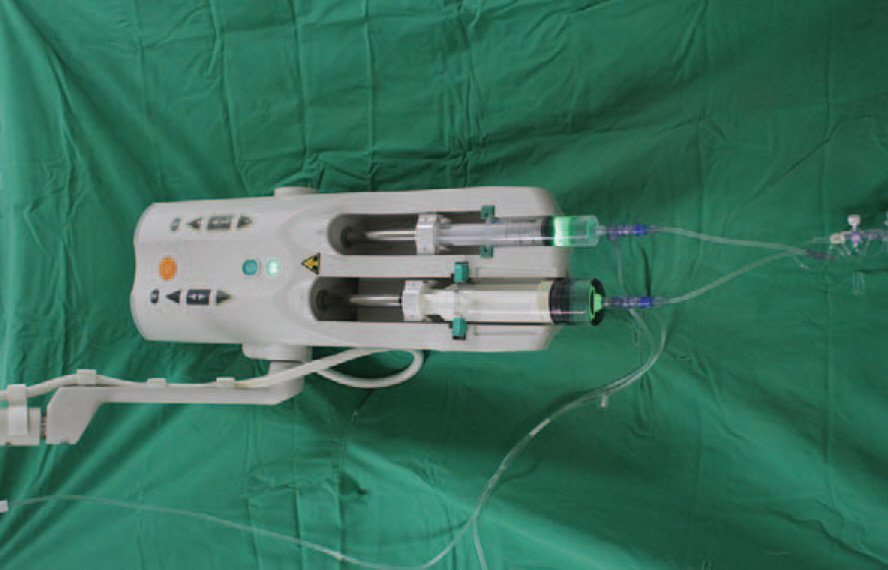J Korean Soc Surg Hand.
2013 Mar;18(1):16-22. 10.12790/jkssh.2013.18.1.16.
Computed Tomography Contrast Media Extravasation in the Upper Extremity: Clinical Features and Treatment Strategies
- Affiliations
-
- 1Department of Plastic and Reconstructive Surgery, Chonbuk National University Medical School, Jeonju, Korea. leenaeho@jbnu.ac.kr
- KMID: 2097597
- DOI: http://doi.org/10.12790/jkssh.2013.18.1.16
Abstract
- PURPOSE
Incidence of radiographic contrast media extravasation has increased owing to the escalating availability of contrast enhanced imaging. Potential complications of extravasation include localized swelling, itching sensation, hypesthesia, erythema, limitation of finger movement, compartment syndrome, skin sloughing, and necrosis. We describe clinical characteristics and treatment of computed tomography contrast media extravasation.
METHODS
A retrospective chart review was performed on 26 consulted patients experiencing contrast extravasation, between January 2005 and December 2011. Age, signs, symptoms, types of contrast administered, volume of extravasation, treatment and patient outcomes were documented and evaluated, retrospectively.
RESULTS
Extravasation of less than 100 mL occurred in 85%. Immediate surgical therapy was necessary in 23% of cases. There were no postoperative complications and it rendered excellent cosmetic outcomes. In 77% of cases, conservative management was recommended, such as elevation and immobilization of extremity, application of ice pack, and careful monitoring.
CONCLUSION
Prevention is the most important for extravasation injuries. Diagnosis and treatment must be made on the spot in order to avoid severe soft tissue damage. Hand surgeons' decision on the necessity of surgical treatment within 6 hours is important in the prognosis of patients.
Keyword
MeSH Terms
Figure
Reference
-
1. Hannon MG, Lee SK. Extravasation injuries. J Hand Surg Am. 2011; 36:2060–5.
Article2. Sistrom CL, Gay SB, Peffley L. Extravasation of iopamidol and iohexol during contrast-enhanced CT: report of 28 cases. Radiology. 1991; 180:707–10.
Article3. Federle MP, Chang PJ, Confer S, Ozgun B. Frequency and effects of extravasation of ionic and nonionic CT contrast media during rapid bolus injection. Radiology. 1998; 206:637–40.
Article4. Sbitany H, Koltz PF, Mays C, Girotto JA, Langstein HN. CT contrast extravasation in the upper extremity: strategies for management. Int J Surg. 2010; 8:384–6.
Article5. Gothlin J, Hallbook T. Skin necrosis following extravasal injection of contrast medium in phlebography. Radiologe. 1971; 11:161–5.6. Seiler JG III, Olvey SP. Compartment syndromes of the hand and forearm. J Am Soc Surg Hand. 2003; 3:184–98.7. Kumar RJ, Pegg SP, Kimble RM. Management of extravasation injuries. ANZ J Surg. 2001; 71:285–9.
Article8. Schaverien MV, Evison D, McCulley SJ. Management of large volume CT contrast medium extravasation injury: technical refinement and literature review. J Plast Reconstr Aesthet Surg. 2008; 61:562–5.
Article9. Tong R. Preventing extravasation injuries in neonates. Paediatr Nurs. 2007; 19:22–5.
Article10. Bellin MF, Jakobsen JA, Tomassin I, et al. Contrast medium extravasation injury: guidelines for prevention and management. Eur Radiol. 2002; 12:2807–12.
Article11. Rowlett J. Extravasation of contrast media managed with recombinant human hyaluronidase. Am J Emerg Med. 2012; 30:2102.e1–3.
Article12. Loth TS, Eversmann WW Jr. Extravasation injuries in the upper extremity. Clin Orthop Relat Res. 1991; (272):248–54.13. Mubarak SJ. A practical approach to compartmental syndromes. Part II. Diagnosis. Instr Course Lect. 1983; 32:92–102.14. Mubarak SJ, Hargens AR. Acute compartment syndromes. Surg Clin North Am. 1983; 63:539–65.
Article15. Whitesides TE Jr, Haney TC, Harada H, Holmes HE, Morimoto K. A simple method for tissue pressure determination. Arch Surg. 1975; 110:1311–3.
Article
- Full Text Links
- Actions
-
Cited
- CITED
-
- Close
- Share
- Similar articles
-
- Compartment Syndrome of the Upper Extremity Induced by Extravasation of Contrast Media after Computed Tomography: A Case Report
- Compartment Syndrome of Forearm Caused by Extravasation of CT Contrast Media: A Case Report
- Extravasation Injury of Forearm by Computed Tomography Contrast Medium
- Subcutaneous Injection Contrast Media Extravasation : 3D CT Appearance
- Indirect Lymphangiography as a diagnostic technique of lymphedema




